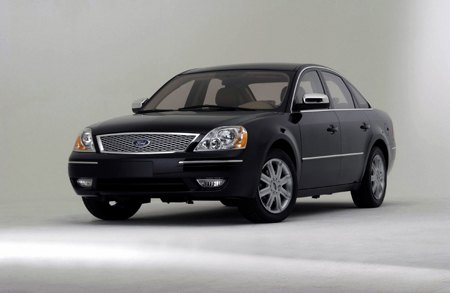CVT RIP?
I can't figure out the appeal of the Continuously Variable Transmission (CVT). Currently featured in the new Ford 500 sedan, the transmission system consists of a pair of cones and a steel drive belt to transfer power. The CVT offers a continuous ratio change (similar to changing gear with a standard manual or automatic) by varying the diameter of the cones, without a step in ratios like a conventional automatic transmission. While conceptually simple, the actual hardware is tremendously complex and expensive. What's more, supporters' claim that the CVT increases economy and performance simply doesn't bear close scrutiny.
Proponents claim that the CVT offers superior mileage by providing a higher overdrive ratio than other transmissions. (Overdrive is another way of saying that the engine turns slower than the driveshaft, which is typical of all modern automatic transmissions.) In the case of the Ford 500's Ford/ZF unit, the overdrive ratio is .41:1. In other words, the engine turns 4/10s of a revolution for every turn of the driveshaft. That's considerably greater than the .69 overdrive ratio of the conventional automatic transmission on offer.
In theory. In practice, the Ford CVT's ratio is 5.41:1; which is a much lower final drive ratio compared to the same car with a conventional automatic. The result is an overall ratio of 2.2:1 in the CVT car vs. 2.3:1 in a car with an autobox. The overall relationship of engine speed to wheel speed is nearly identical.
At 70 mph, the tach needle would point to the same number, no matter which transmission was installed. When cruising down the expressway, the engines in both cars would be going the same speed, doing the same amount of work, and thus getting the same mileage. The comparison remains valid at any cruising speed over about 30, where the automatic transmission is in overdrive.
It's a similar situation for off-the-line acceleration. The CVT has much less torque multiplication, but a lower-geared final drive. The Ford uses a torque converter between the engine and the gearbox to further increase torque multiplication at launch. Since Ford uses torque converters with the same torque multiplication (effectively the same as a gear reduction), the overall ratio between the engine and the wheels is the same. With the same gear ratios, the cars will have the same acceleration, no more and no less.
The CVT's main claim to fame is that it keeps the engine at a constant speed, either the most efficient or the most powerful, while accelerating. In the days when engines had narrow power bands and peaked torque curves, this may have been more than a theoretical advantage. But today's engines have torque curves as flat as Kansas, and power curves to match. And today's automatic transmissions have five or six geared speeds, usually with only about 18-25% ratio differences between ratios. In other words, modern engines have essentially the same amount of power or torque over a relatively wide RPM range, and today's automatic transmissions have a narrow enough ratio spread between their gears to use all of the torque and power that the engine produces.
Every transmission suffers internal power losses, but internal losses in the CVT's hydraulic control system are higher than that of a conventional automatic transmission. The hydraulic control systems have to operate at higher pressures or flows, to squeeze the steel cones on steel belts, diverting more energy from the engine and leaving less to move the car. Since the CVT's torque converter is similar to the conventional transmission, internal efficiency of the CVT is lower. This hurts the CVT's ability to deliver the promised higher mileage.
The CVT also requires special, expensive fluid to withstand the heat and pressure demands, and scheduled oil changes. In fact, all things being equal, the CVT has no performance, economy or reliability advantages over a more conventional system. But this equation doesn't include ergonomic factors, which put the CVT at a distinct disadvantage.
It's clear that people aren't comfortable driving a car without transmission shift 'feel"; they like to know when their transmission is in "low gear" or 'high gear'. Obviously, a seamless CVT transmission doesn't transmit this kind of information. As a result of customer feedback, Audi felt compelled to programmed their CVT to have steps, just like a conventional automatic transmission. This made drivers feel better, but defeated the CVT's original purpose.
Of course, I'm not the only one who fails to see the rationale for a CVT. After having invested millions in new technology and a new plant, rumor has it that Ford is about to discontinue the CVT option from the 500, writing off their investment before the model year has properly begun. The move would be a hugely expensive about-face, but it's the right thing to do.
More by Bob Elton
Latest Car Reviews
Read moreLatest Product Reviews
Read moreRecent Comments
- Varezhka Maybe the volume was not big enough to really matter anyways, but losing a “passenger car” for a mostly “light truck” line-up should help Subaru with their CAFE numbers too.
- Varezhka For this category my car of choice would be the CX-50. But between the two cars listed I’d select the RAV4 over CR-V. I’ve always preferred NA over small turbos and for hybrids THS’ longer history shows in its refinement.
- AZFelix I would suggest a variation on the 'fcuk, marry, kill' game using 'track, buy, lease' with three similar automotive selections.
- Formula m For the gas versions I like the Honda CRV. Haven’t driven the hybrids yet.
- SCE to AUX All that lift makes for an easy rollover of your $70k truck.


































Comments
Join the conversation